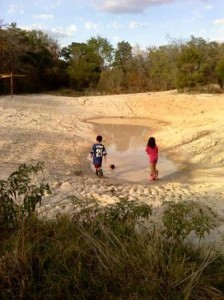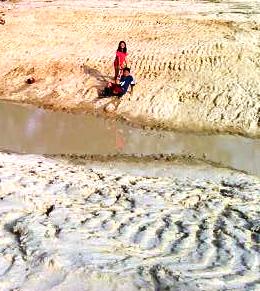“We don’t stop playing because we grow old; we grow old because we stop playing.” -George Bernard Shaw
The Texas drought may have dried up our pond, but it offered our two youngest children the opportunity to play in the biggest mud puddle they’d ever seen. I told them they could play in the mud puddle as long as they wore their boots and didn’t get too messy. All moms reading this blog are chuckling to themselves…you know that it wasn’t five minutes before the first child went in past the top of their boot. At that point, I quit worrying about the muddy mess and decided to make it into muddy math.

“It is paradoxical that many educators and parents still differentiate between a time for learning and a time for play without seeing the vital connection between them.” -Leo Buscaglia
I talk to teachers and parents about simple ways to develop mathematical concepts in every situation. I emphasize that the greatest tool they have is their ability to ask questions, make a real-world connection, and engage their children and students in math that’s FUN. The following list is comprised of what might have caused parental alarm and a negative parental response, but was transformed into meaningful math conceptual development.
1. The children tried to go all the way across the pond without their water going into their boot.
If your boot is 12’’ tall, how deep do you think the water is?
2. Both of the children don’t make it across the pond and are standing in water that is pouring into their boot.
Since there’s water pouring into your boot, use what you know about the height of your boot and the height of the water on your leg to estimate how deep the water is. Use this same information to see how much deeper the water is at different locations in the pond.
3. One of them stands in the middle of the pond too long and his boot is stuck. He’s about to fall over—especially when he starts laughing because his foot came out of his boot.
How deep do you think the mud is? Compare that depth to the depth of the water. Where do you think the mud is the deepest? Why?
4. Both children can barely make it out of the water because there is so much water in their boots.
How much water is in your boot? What is the type of measurement you are making when you estimate the amount of liquid something can hold?
5. Now that their boots are completely wet and most of their clothes are wet they decide to complete the drenching of their clothing by racing each other across the pond.
How fast can you run across the pond? Do you think you can run as quickly with your boots full of water? Why or why not? Try it and see if you’re right.
6. Since they’ve begun to run across the pond laughing, the inevitable is going to happen….complete immersion.
How long will it take before someone falls in?
7. After immersion of at least one child, they sit on the side of the pond to wring out their clothes and dump their boots for the hundredth time.
Did filling your boots with water and drenching your clothing make a difference in the amount of water left in the pond? Why not? How could you measure the amount of water in the pond?
8. While they dump their boots they notice that the water is flowing down certain portions of the bank faster.
How many seconds does it take for water to go from the top of the hill to the giant puddle? Which goes faster—crevasse or flat surface? What is that called?
9. They’ve grown tired of running across the pond and are taking turns pouring water out of their boots down the hill.
What is the difference between kinetic and potential energy? What does the pond represent? What does the pouring of the pond water represent?
10. The language of science appeals to my daughter who knows that math and science go together and that both are everywhere and in everything.
How many different things can you see near the pond that have potential energy? Kinetic energy? (Their favorite form of kinetic energy is themselves running down the hill. Their favorite form of potential energy is stopping just short of falling in the pond…of course, one of them does happen to fall in.)
11. One of them comes up to me and shows me how wet they are and how little water and mud is stuck to their hair.
I ask them, “What is a good probability word that describes the likelihood of you having to take a shower? What is the percentage chance of you having to use soap?”
As we trudge back up the hill and away from the pond we pass an armadillo digging in the dirt. We decide that the likelihood of the armadillo taking a shower is never and we sit down in the dirt to watch him finish his hole. The experience had brought all of us a little mud, a little math, and a LOT of fun!
“You can discover more about a person in an hour of play than in a year of conversation.” -Plato


